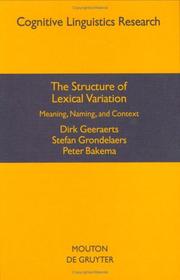| Listing 1 - 10 of 23 | << page >> |
Sort by
|
Book
Year: 1997 Publisher: Leuven KUL. Laboratory of experimental psychology
Abstract | Keywords | Export | Availability | Bookmark
 Loading...
Loading...Choose an application
- Reference Manager
- EndNote
- RefWorks (Direct export to RefWorks)
Digital
Abstract | Keywords | Export | Availability | Bookmark
 Loading...
Loading...Choose an application
- Reference Manager
- EndNote
- RefWorks (Direct export to RefWorks)
Book
ISBN: 9788270997411 8270997412 Year: 2013 Volume: 2 Publisher: Oslo Novus Press
Abstract | Keywords | Export | Availability | Bookmark
 Loading...
Loading...Choose an application
- Reference Manager
- EndNote
- RefWorks (Direct export to RefWorks)
Sociolinguistics --- Dialectology --- Europe
Book
ISBN: 9070389606 Year: 1999 Publisher: Amsterdam : Meertens instituut,
Abstract | Keywords | Export | Availability | Bookmark
 Loading...
Loading...Choose an application
- Reference Manager
- EndNote
- RefWorks (Direct export to RefWorks)
Lexicology. Semantics --- Dutch language --- Academic collection --- #KVHA:Lexicologie; Nederlands --- #KVHA:Kleding --- #KVHA:Voetbal

ISBN: 3110873060 3110143879 9783110143874 9783110873061 Year: 1994 Volume: 5 Publisher: Berlin ; New York : M. de Gruyter,
Abstract | Keywords | Export | Availability | Bookmark
 Loading...
Loading...Choose an application
- Reference Manager
- EndNote
- RefWorks (Direct export to RefWorks)
The Structure of Lexical Variation : Meaning, Naming, and Context
Lexicology. --- Language and languages --- Characterology of speech --- Language diversity --- Language subsystems --- Language variation --- Linguistic diversity --- Variation in language --- English language --- Variation. --- Lexicology --- Academic collection --- #KVHA:Lexicologie --- #KVHA:Taalkunde --- 801.3 --- Variation --- Lexicografie. Woordenboeken --- 801.3 Lexicografie. Woordenboeken --- Lexicology. Semantics --- Dutch language --- Lexicologie --- Variation (Linguistique) --- Language and languages - Variation
Digital
ISBN: 9783110873061 9783110143874 Year: 2012 Publisher: Berlin ;; Boston De Gruyter Mouton
Abstract | Keywords | Export | Availability | Bookmark
 Loading...
Loading...Choose an application
- Reference Manager
- EndNote
- RefWorks (Direct export to RefWorks)
Dissertation
Year: 2000 Publisher: S.l. : s.n.,
Abstract | Keywords | Export | Availability | Bookmark
 Loading...
Loading...Choose an application
- Reference Manager
- EndNote
- RefWorks (Direct export to RefWorks)
Book
Year: 2020 Publisher: Antwerpen deSingel
Abstract | Keywords | Export | Availability | Bookmark
 Loading...
Loading...Choose an application
- Reference Manager
- EndNote
- RefWorks (Direct export to RefWorks)
Dissertation
Abstract | Keywords | Export | Availability | Bookmark
 Loading...
Loading...Choose an application
- Reference Manager
- EndNote
- RefWorks (Direct export to RefWorks)
Dissertation
Year: 2000 Publisher: Leuven : s.n.,
Abstract | Keywords | Export | Availability | Bookmark
 Loading...
Loading...Choose an application
- Reference Manager
- EndNote
- RefWorks (Direct export to RefWorks)
| Listing 1 - 10 of 23 | << page >> |
Sort by
|

 Search
Search Feedback
Feedback About UniCat
About UniCat  Help
Help News
News